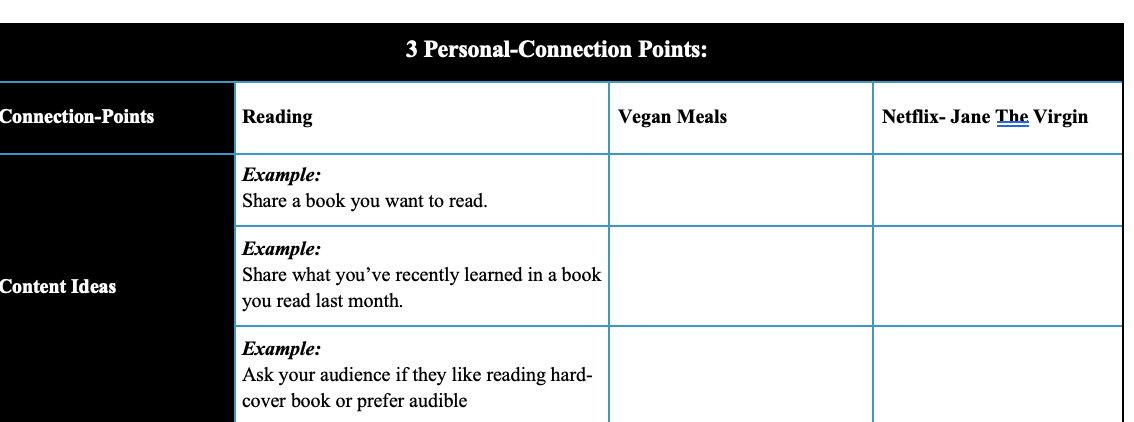
Creating content for Instagram is not as hard as people think it is.
The problem that most business owners struggle with is not creating content in the general sense; it’s creating relevant content for their target audience.
One of the main reasons why it’s hard to create content for your target audience is because you:
(1) have not worked on defining your market and niche properly, and
(2) because you don’t know how to find your target audience (which includes your messaging).
It used to annoy me whenever I heard Educators talk about “Avatars” and “Ideal Clients.”
Ultimately, I realized it was the terminology (not the strategy) that was turning me off, I found that I resonated better with the term – target audience.
This completely changed how I created a lot of my social media content, email marketing content, video-marketing content, blogging content, and more.
If you think these two elements don’t matter, you’re wrong. And, honestly, you’ll continue to struggle with creating content for Instagram.
If you’re a product or service based business it’s imperative for you to show people what you do (your niche – how your serve them) or what solutions you have for them (products & services).
The key thing is to not be salesy.
You can convert without saying “buy from me.”
With recent changes to Instagram such as IGTV and Instagram Stories, you can connect and engage with your target audience easier than before. Instagram has also placed IGTV and Instagram Stories at the top of the Explore page, so you need to focus on content that will perform best using these two in-app methods.
Most business owners have not properly defined their market and niche which inadvertently affects the messaging they share on social media platforms and the way potential customers engage or choose not to engage with them. For example. have you seen those 90 plus comment Facebook threads with the main caption stating, “Looking for a photographer”. The result is often a bunch of random photographers commenting on the same post, but if you really look at the comments (the photographers that are commenting) are NOT from the same market which makes it even harder for the person that created the original post to narrow down who to choose from.
Note: Much like a Google search, only the first 30-40 comments are looked at by the person that originally posted it, so if you’re commenting, knowing your niche will make you stand out.
Tips for Defining Your Market & Niche:
- Your market is WHAT you do. (Photographer, Florist, Lawyer)
- Your niche is WHO you serve & should include HOW you serve them. (“I serve joyful Brides that love intimate moments captured in luxurious locations.)
Tips for Defining Your Target Audience:
- After you define your niche (which is WHO you serve & should include HOW you serve them), you now have the Umbrella to create subcategories that relate to your target audience. This helps you to develop content they’ll like, resonate with, engage with, and want to see.
Your Goal: Define your audience/customer by getting to know everything you can possibly know about him/her. Download this interactive PDF File to dive deeper into this here.
Use this information in all of your marketing moving forward.
So, you’ve completed defining your market, niche, and target audience.
Now you’re ready to develop content for your social platform, website, and more using three connection points.
This method works exceptionally well on social media platform such as Instagram. Here are some tips to get you started.
Tips for Developing 3 Personal-Connection Points:
Write down 5-7 things that you like, do at leisure, or love that do not involve your business. Choose (3) from the list below that you are comfortable sharing publicly.
Tips for Developing 5 Business-Connection Points:
Write down 5-7 things that your customers/clients come to you for (whether service or product related). Be sure to include (3) FAQs that you hear often, and (3) categories.
Now that you have these connection points, you will use them as categories to generate your content ideas. Below is a quick way to develop these ideas yourself.

Now that you have a working strategy to implement, head over to Google Docs or Spreadsheet and create your own layout to use this method for developing content ideas.
Be sure to use relevant GEO-Tags and Hashtags when posting on Instagram once you’ve written out a relevant and engaging caption.
If you’re using an application like Planoly, be sure to still engage with your audience.
Don’t develop a set it and forget it mindset, you still need to connect and engage.
Ready to uplevel your Instagram strategy, connect with your audience, and build your brand? Get our Ultimate Guide to Instagram for Business.



